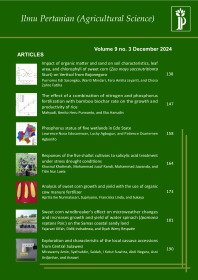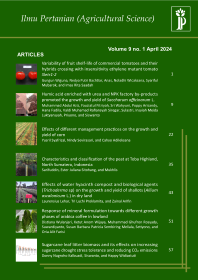Growth and Yield of Upland Rice Under Intercropping System with Soybean in Sandy Coastal Area
Fajrin Pramana Putra(1*), Prapto Yudono(2), Sriyanto Waluyo(3)
(1) Department of Agronomy, Faculty of Agriculture, Universitas Gadjah Mada Jln. Flora no. 1, Bulaksumur, Sleman, Yogyakarta 55281
(2) Department of Agronomy, Faculty of Agriculture, Universitas Gadjah Mada Jln. Flora no. 1, Bulaksumur, Sleman, Yogyakarta 55281
(3) Department of Agronomy, Faculty of Agriculture, Universitas Gadjah Mada Jln. Flora no. 1, Bulaksumur, Sleman, Yogyakarta 55281
(*) Corresponding Author
Abstract
Keywords
Full Text:
PDFReferences
Adeniyan, O. N., O. A. Aluko, S. O. Olanipekum, J. O. Olasoji, and V. O. Aduramigba-Modupe. (2014). Growth and yield performance of cassava/maize intercrop under different plant population density of maize. Journal of Agricultural Science 6 (8): 35–40. http://dx.doi.org/10.5539/jas.v6n8p35.
Amanullah. (2015). Specific leaf area and specific leaf weight in small grain crops wheat, rye, barley, and oats differ at various growth stages and NPK Source. Journal of Plant Nutrition 38 (11): 1694-1708.
Alexander, M. (1977). Introduction to Soil Microbiology. 2nd Edition. John Wiley and Sons; New York-Chichaster-Brisbane-Toronto-Singapore. 472 pp.
Al-Omran, A.M., A.M. Falatah, A.S. Sheta, and A.R. Al-Harbi. (2004). Clay deposits for water management of sandy soils. Arid Land Research and Management 1: 171–183.
Badan Pusat Statistik. (2016). Penduduk Indonesia menurut Provinsi 1971, 1980, 1990, 1995, 2000 dan 2010. [On line] Available at: https://www.bps.go.id/linkTabelStatis/view/id/1267 [Accessed 13 Apr. 2017].
Ghosh, P. K., M. Mohanty, K. K. Bandyopadhyay, D. K. Painuli, and A. K. Misra. (2006). Growth, competition, yield advantage and economics in soybean/pigeonpea intercropping system in semi-arid tropics of India I. Effect of subsoiling. Field Crops Research 96: 80–89.
Ilkaee, M. N., F. Paknejad, and M. Zavareh. (2011). Prediction model of leaf area in soybean (Glycine max L.). American Journal of Agricultural and Biological Sciences 6 (1): 110–113.
Inal, A., A. Gunes, F. Zhang, and I. Chakmak. (2007). Peanut/maize intercropping induced changes in rhizosphere and nutrient concentrations in shoots. Plant physiology and biochemistry 45: 350–356.
Kementrian Pertanian. (2016). Basis data statistik pertanian. [online] Available at: http://aplikasi.pertanian.go.id/bdsp/newkom.asp [Accessed 13 Apr. 2017].
Munekage, Y. N. 2016. Light harvesting and chloroplast electron transport in NADP-malic enzyme type C4 plants. Current Opinion in Plant Biology 3: 9–15. http://dx.doi.org/10.1016/j.pbi.2016.03.001
Pasau, P., P. Yudono, dan A. Syukur. 2008. Pergeseran komposisi gulma pada perbedaan proporsi populasi jagung dan kacang tanah dalam tumpangsari pada regosol Sleman. Ilmu Pertanian 16 (2): 60–78.
Peoples, M. B., D. F. Herridge and J. K. Ladha. (1995). Biological nitrogen fixation: An efficient source of nitrogen for sustainable agriculture production. Plant and Soil 174: 3–28.
Putra, S. (2011). Pengaruh jarak tanam terhadap peningkatan hasil padi gogo verietas Situ Patenggang. Agrin. 15 (1): 54–63.
Rajiman, P. Yudono., E. Sulistyaningsih, and E. Hanudin. (2008). Pengaruh pembenah tanah terhadap sifat fisik tanah dan hasil bawang merah pada lahan pasir pantai Bugel Kabupaten Kulon Progo. Agrin. 12 (1): 67–77.
Article Metrics
Refbacks
- There are currently no refbacks.
Ilmu Pertanian (Agricultural Science) ISSN 0126-4214 (print), ISSN 2527-7162 (online) is published by Faculty of Agriculture Universitas Gadjah Mada collaboration with Perhimpunan Sarjana Pertanian Indonesia (PISPI) and licensed under a Creative Commons Attribution-ShareAlike 4.0 International License.














